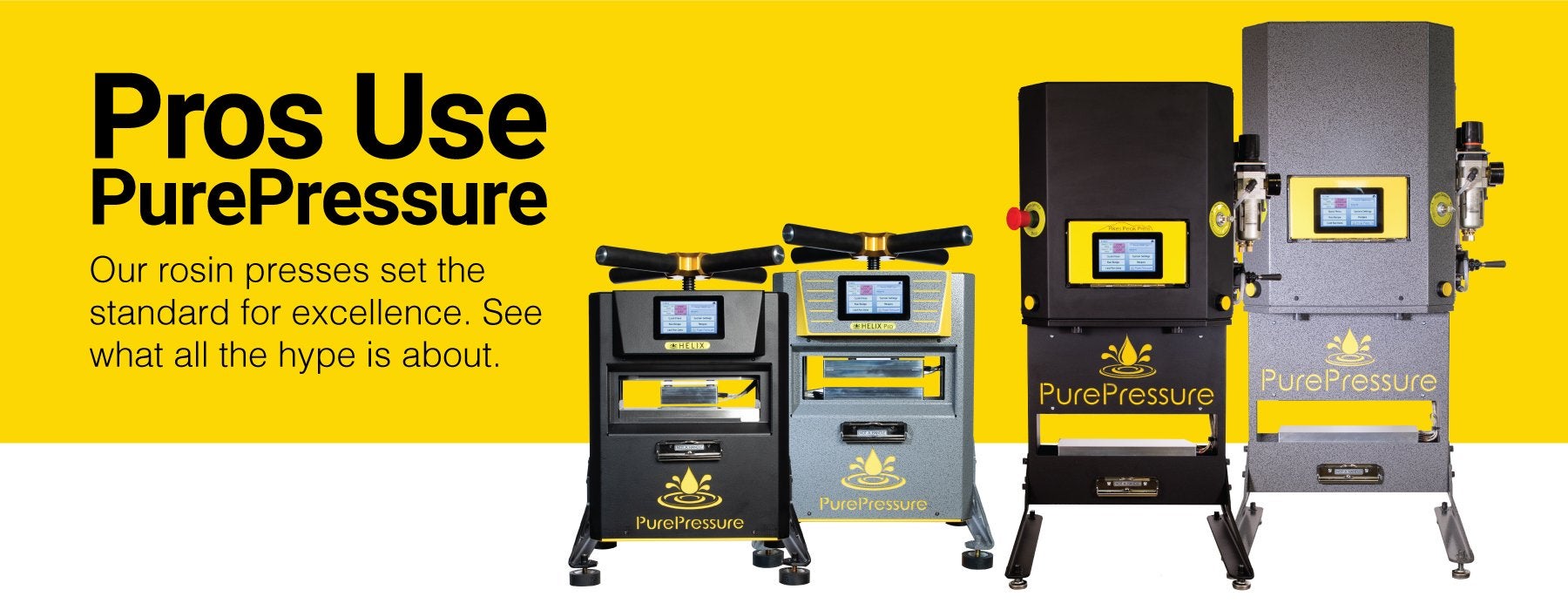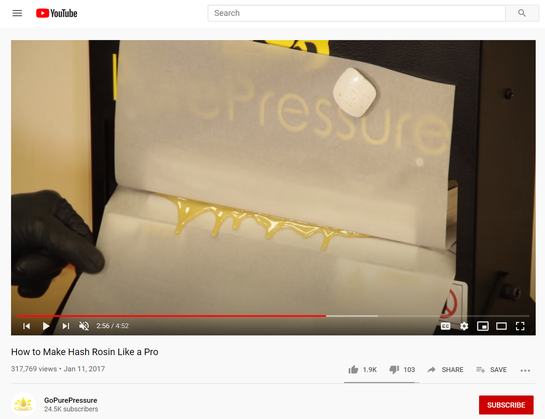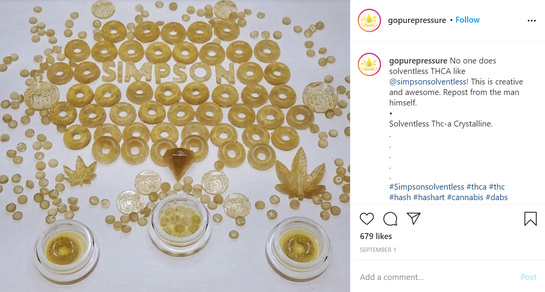How to Create a Winning B2B Content Strategy
Our guide to everything B2B content marketing, from content strategy fundamentals to content types that engage a B2B target audience.
Read More
In 2018, a former Coca-Cola executive called CBD the “new avocado toast,” which was perhaps the clearest sign that the chemical in the cannabis plant — which offers benefits for anxiety, insomnia, and pain management but does not get users high — was having a cultural moment.
A few months later, singer Willie Nelson launched a line of CBD-infused coffee. Since then, we’ve seen CBD-infused toothpicks and potato chips, and even a line of tree-free CBD toilet paper called Hempies.
How exactly each of these brands acquires CBD is unclear. But sitting in-between the cannabis plant and the ability to manufacture CBD-infused products is extraction equipment — and that’s where a company like PurePressure comes in.
PurePressure manufactures extraction equipment for the cannabis industry. Its machinery uses heat, pressure, ice, and water instead of chemicals or solvents. It produces a higher-quality end product, whether in the form of edibles, oils, or vapors, according to Eric Vlosky, PurePressure’s director of marketing and business development. In a recent AdRoll Live episode, Vlosky compared PurePressure’s products to the equipment used by craft brewers.
“What are the … best craft brewers using to make their beer?” he asked. “The equipment we make is the equivalent in the cannabis industry.”
Instead of brewers, PurePressure’s primary customers are caregivers and laboratories.
“Our customers are either very serious home growers who have the legal ability in their state to make these kinds of concentrates at home,” Vlosky said. “But the majority of our customers — and where our business is headed — is much more business-to-business sales and working to sell to these big licensed laboratories that have even more stringent licensing requirements.”
That means PurePressure must sell and market to wildly different audiences — from commercial customers who spend hundreds of thousands of dollars to individuals buying $10 filter bags.
“So that's actually pretty challenging because most businesses, they kind of have this price point that they're selling things within,” he said. “But we're trying to market and attract customers on all ends of that spectrum, and that can be a little challenging.”
Image: PurePressure
PurePressure’s secret weapon: content marketing — and video in particular.
In fact, in a recent interview, Vlosky called video production the company’s number one lead driver in generating brand awareness. However, this hasn’t come cheap. Brands should be prepared to invest in quality videos to attract an audience, recommends Vlosky.
It’s important to note that PurePressure operates in a small niche, so its target audience is also relatively small.
“[It’s] not like we're selling shoes where everybody wears shoes, and the pool to market to those people is very different,” Vlosky said. “So I knew that we would need to stand out with our media and our brand aesthetic to really look a lot better and a lot more legitimate than our competitors. And that kind of is what set us down that road of making big investments in our content marketing right off the bat and continuing it ever since.”
He even called the extraction process featured in some PurePressure videos “basically rosin porn that people want to come and watch.” (According to cannabis website Leafly, rosin is “an extraction process that utilizes a combination of heat and pressure.”)
“I knew that I was going to get a lot more traction with my videos if they just looked a lot better than my competitors because it's not that hard to get a phone and record something,” he said. “It's a lot more work to create an edited, scripted, purposeful video. So one of the big engagement strategies we've taken is just quality over quantity.”
In fact, he likened PurePressure’s video advertising approach to that of advertising powerhouse Nike.
“It's kind of like how Nike is going to market the dunks to people that are playing casual pickup basketball, like, ‘This is what the ultra-pros do, but you can do it, too,’” Vlosky said. “So we have taken a fairly similar marketing approach in just getting really attractive marketing, whether it's videos, images, blogs, [and] really trying to take a keen eye towards the aesthetics of what works.”
Education is also a significant component of PurePressure’s content strategy.
“There's very little education about extracted products in the general world,” he explained. “It's just kind of like, ‘Cool, it's a vaporizer … let's enjoy it.’ But as people become more aware of what they're actually consuming, people are going to start thinking a lot more about it just like farm-to-table organic food. That's really where we're fitting in and trying to educate people on what they are consuming.”
Image: PurePressure
PurePressure publishes blogs, which serve as informational resources to current and potential customers. They’re the backbone of our SEO efforts, according to Vlosky.
Beyond that, visual content is where PurePressure shines.
Take YouTube, for example. Vlosky calls it one of the brand’s most successful channels thanks to high-quality educational content and “creating a place where people can kind of dive in and say, ‘Wow, I don't see anyone else putting out this kind of information. I really like these guys. I want to know what else they have going on,’” Vlosky explained.
That includes a video series in which PurePressure interviews hash makers about their businesses and reviews products.
“It's really engaging because we get a lot of people who tune in, and they want to know what these … hash makers think,” Vlosky said. “We ask them a lot of really interesting questions. And we've gotten some really, really great views off of that.”
It’s a win-win as PurePressure uses these opportunities to champion its customers. “Our prospects can see these brands that are being successful with our equipment,” Vlosky added.
YouTube has also boosted the brand’s SEO profile by helping PurePressure rank for search terms.
Instagram, however, is PurePressure’s most important social media channel because in part “the cannabis industry really lives on Instagram,” and “having at least a reasonably strong presence on Instagram is a signaling mechanism to our audience that we are a legitimate high-powered company,” according to Vlosky.
Here, the brand reposts high-quality, user-generated content produced by customers.
“Our strategy with Instagram is to show really sexy imagery because when people are on Instagram, they're not trying to read about politics … they're trying to forget about their day, and just kind of zone out for a little bit,” Vlosky said.
Instagram also helps fill PurePressure’s video production void during the pandemic through Instagram Live, where Vlosky hosts Q&As with hash makers and other industry experts.
“And even though those videos don't have an enormous amount of views, they really bring an enormous amount of credibility to our brand because people come, and they see that it's not just an influencer saying, ‘Hey, look at how cool their products are,’” he said. “We're having an in-depth discussion about topics that our audience is interested in, so that really helps build our credibility, but … we're championing … these top labs.”
PurePressure also relies on Instagram to gauge what its community is interested in through posts and comments. For example, the brand recently shot a video about CBD flower — which can be purchased legally in 47 states — and transformed it into gummies and edibles, after noticing a growing number of virtual questions about the concept.
“So, we're just always kind of looking around, listening to our customers, and seeing what kind of questions are out there and trying to address those questions and address the areas that seem to be the least served, information-wise,” he explained.
PurePressure engages with customers through comments they leave on social channels by either answering questions or tagging someone who might have a good answer.
“We try really hard to engage with our community because our community can be … pretty demanding,” he said. “And I think that a lot of people in our space would probably feel the same way about their audience and their customers, and it's no different for us, that they really want us to set a high bar. And people get really upset if they ask something and you don't answer them. So we try really hard to give them some good answers.”
Image: PurePressure
But not all social channels are the right fit for PurePressure. Twitter, for example, “requires too much upkeep,” according to Vlosky. PurePressure doesn’t use Facebook much either after the brand’s ad account was banned.
“Because we're kind of in the space of cannabis — even though we don't cultivate, process, or distribute — at some point, somebody reported us,” he said. “I guess we ran afoul of their advertising policy. So we just kind of put Facebook on maintenance mode. But we don't get a ton of engagement there anyway.”
He has to be similarly careful with Google advertising, but said he’s too scared to advertise cannabis-related content on YouTube and risk a ban that might jeopardize the brand’s extensive video library.
“If I put an ad up and get some pre-roll going and our account gets banned, we're talking about years of work,” he said. “It would crush me if our YouTube channel got deleted, so I just can't take that risk. So we have to play it really safe.”
These limitations are one of the biggest marketing challenges in the cannabis industry.
“There's a lot less advertising that we can do,” Vlosky said. “So we have to get really creative with how we advertise and how we get content out there because I can't just buy ad placements like other brands can necessarily.”
Cannabis extraction equipment certainly isn’t as well-known or widely used as shoes. But for PurePressure’s customers and prospects, it’s arguably just as important. By tapping into explainer videos, live Q&As with influencers, and the cannabis community on Instagram, PurePressure has found its niche and continues to build both awareness and relationships in a growing industry.
Last updated on December 3rd, 2025.


